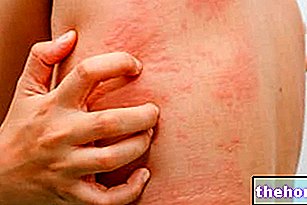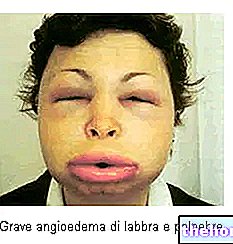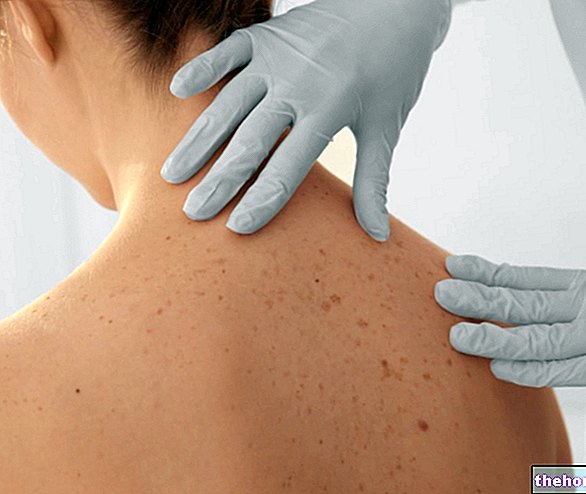Generality
Nummular eczema is a dermatitis, or an inflammatory skin disease, which causes very characteristic skin rashes.
The exact causes have not yet been clarified, although they have been the subject of extensive research.

For an accurate diagnosis, a physical examination, allergy test, and several culture tests are required.
The therapeutic choice is wide, but identifying the most appropriate treatment is not always easy.
What is nummular eczema?
Nummular eczema or discoid eczema is an inflammatory skin disease that causes the appearance of brownish-red oval or circular spots in various parts of the body. In particular, the areas usually most affected are: the forearms, hands, feet , the trunk (chest, belly and back) and the legs.
Nummular eczema is also known as nummular dermatitis.
DIFFERENT TYPES OF ECZEMI
Eczema and dermatitis are two synonyms, as they both refer to an "inflammation of the skin.
In addition to nummular eczema, there are other types of eczema, for example:
- Atopic eczema, also known as atopic dermatitis. It is a skin inflammation whose origin there are genetic and environmental components (exposure to allergenic substances, irritants). It mainly affects newborns and is often associated with asthma and hay fever.
- Contact eczema, more commonly known as contact dermatitis. The inflammatory state of the skin arises after contact with certain substances, which the body considers dangerous, even if they are not. It is, in fact, an allergic reaction.
- Varicose eczema. It is an inflammation of the skin that takes place in the legs of those suffering from varicose veins.
EPIDEMIOLOGY
Nummular eczema can affect anyone at any age, however it is much more common in males between the ages of 50 and 70.
According to an Anglo-Saxon statistical study, nummular eczema would have an annual incidence of about 2 cases per 1,000 people.
Its appearance is almost always associated with dry skin (so much so that it is believed there may be a link between the two conditions) and, sometimes, with atopic dermatitis, with which, however, there does not seem to be any particular connection.
Causes
The causes of nummular eczema are currently being studied, as it has not yet been clarified what exactly triggers skin inflammation.
THE MOST ACCREDITED THEORY
The most accredited hypothesis (but still to be proved) would concern the association with dry skin; this condition, in fact, would make the skin less protected and would allow the penetration of some substances, such as soaps and detergents, with harmful, inflammatory and irritating effects.
OTHER HYPOTHESIS
The hypothesis that sees dry skin at the origin of discoid eczema is not the only one.
According to some studies, in fact, it would seem that nummular dermatitis was caused by the bite or sting of an insect.
According to others, however, it appears to be triggered by taking certain medicines, such as interferon and ribavirin for the treatment of hepatitis C or TNF-alpha blockers (anti-TNF-alpha) for the treatment of arthritis.
Symptoms and Complications
Nummular eczema causes the appearance of skin rashes with highly variable characteristics. In fact, these spots can be:
- Oval or circular
- A few millimeters or a few centimeters large
- Pink or brownish-red in color
- Dry, scaly and cracked or moist, swollen and blistered (i.e., covered with blisters).
- Home to itching, irritation, burning and pain
The affected areas can be more than one: there are, in fact, patients with only one affected area and patients with several regions involved. In this second case, the skin between the various affected regions is not normal, but tends to be very dry.
WHERE DO THE SLUTS FORM?
The patches can appear anywhere on the body. However, it is very rare that they arise on the face or scalp, while it is very common that they form in the lower parts of the legs, in the forearms, in the trunk (understood as chest, belly and back), in the hands and feet.
SPONTANEOUS RESOLUTION
Even if not treated with the proper treatments, nummular eczema can heal on its own; however, the spontaneous healing process could take several weeks, if not months.
INFLUENCE OF CLIMATE
The symptoms of nummular eczema tend to worsen in the presence of dry and / or very cold climatic conditions; vice versa, they tend to improve in the presence of a sunny and humid climate.
IS IT CONTAGIOUS?
Although we do not know the precise triggering causes, nummular eczema is certainly not caused by a contagious infectious agent; therefore, it is impossible that it can spread with simple physical contact between people.
COMPLICATIONS
In some moments of the day (for example at night), the itching becomes very intense, so much so that the patient is led to rub the skin to feel relief. The rubbing, however, involves the lesion of the skin, especially if the affected area is covered by some blister. The skin wound can be followed by a "bacterial infection, which determines the onset of further disorders such as high fever, the appearance of pus and acute pain.
Diagnosis
Discoid eczema manifests itself with evident signs, which, however, can be confused due to their similarity with the signs of other dermatological diseases, caused for example by fungi (ringworm or fungal mycosis) or by other substances present in the " environment.
Therefore, in order to correctly diagnose nummular eczema, not only a thorough physical examination is needed, but also several culture and allergy tests.
- Physical examination. In addition to carefully observing the suspicious area, the dermatologist asks the patient certain questions regarding his clinical history. This, in fact, can contain fundamental information, regarding the causes and how the dermatitis appeared. For example, knowing that the patches appeared after contact with certain substances could lead to the exclusion of nummular eczema and suggest contact dermatitis. However, any hypothesis made should then be confirmed by more specific laboratory tests, such as culture and allergy tests .
- Laboratory culture tests. Culture tests are performed on a sample of scales and a swab of skin (skin swab), both taken from the suspect area. From the "analysis of the scales it is clear if the patches are due to a" fungal infection (ringworm) or not. The absence of fungi could mean that nummular eczema is indeed occurring.
With the skin swab, on the other hand, it is clear whether there has been a bacterial contamination. If the outcome of this second test is positive (ie bacteria are present in skin wounds or blisters), antibiotic drugs must be administered to the patient. . - Allergy tests. They are used to rule out the possibility of contact dermatitis. On the skin of the patient under observation, in fact, various substances are applied that could trigger an allergic reaction; if there is no abnormal response to simple contact, the diagnosis leans in favor of nummular eczema.
Treatment
There are several therapeutic treatments for the treatment of nummular eczema; however, finding the right therapy and healing from this skin inflammation is not always that simple, as each patient represents a case in itself. Some individuals, in fact, respond very well to a certain remedy that, on the other hand, for other subjects is ineffective and, sometimes, even counterproductive (for example, an allergic reaction may take place).
Here are all the possible treatments:
- Emollients
- Topical corticosteroids
- Oral corticosteroids
- Antibiotics
- Antihistamines
EMOLLIENTS
What are emollients? All preparations capable of softening, moistening and making the superficial layers of the skin more elastic are considered emollients. Generally, they are based on oily substances.

Their application stops the irritation and allows the skin to restore its normal appearance.
Types of emollients. There are several types of emollients commercially available; there are, in fact, creams, lotions and ointments, which have different quantities of oily substances. Generally, the higher the content of oily substances, the more effective the emollient is; however, the choice of the most suitable product also depends on the area affected by the spots and the type of skin.
How are emollients applied? They must be applied several times during the day and in good quantities. It is advisable not to rub them, but to spread them gently and always in the same direction as the skin hair. In case of very dry skin, the application should be done every 3-4 hours.
Immediately after a shower, it is very important to spread the preparation used, because bathroom cleaners tend to dry out the skin.
Side effects. Emollients are one of the most used products in case of nummular eczema and dry skin, because they rarely cause side effects. The only contraindications could be allergic reactions to one of the substances contained in the emollient preparation. Therefore, at each first application, it is recommended to apply small amounts of the product to see how the skin reacts.
CORTICOSTEROIDS FOR TOPICAL OR LOCAL USE
What are corticosteroids? Corticosteroids are powerful anti-inflammatory drugs belonging to the steroid family. Steroids are hormones that are also naturally present in the human body. For topical or local use it means that the preparation is applied directly to the affected area.
Types of topical corticosteroids. There are more or less potent corticosteroids. It is possible to apply them in the form of creams or ointments, depending on the affected area and the severity of the dermatitis. For example, ointments are particularly suitable for very severe nummular eczema; creams, on the other hand, are very good for nummular eczema. moderate.

How are corticosteroids applied? Before using any corticosteroid drug, you should contact your doctor to be informed on how to administer.
In general, these medicines should not be applied more than twice a day and for more than 3-4 weeks. Before applying to the affected area, it is recommended to soften the skin with an emollient, in order to favor the pharmacological effects of the corticosteroid in use.
Side effects. At the first administration, the patient may feel a slight discomfort, which, however, gets used to in a short time. Possible side effects are: acne, increased hair growth, telangiectasia and skin thinning. Their occurrence is usually due to prolonged use of the corticosteroid.
ORAL CORTICOSTEROIDS
Oral corticosteroids differ from topical corticosteroids only in the route of administration, which is by mouth, and in the type of side effects.
Main side effects of oral corticosteroids:
- Hypertension
- Weight gain
- Osteoporosis
ANTIBIOTICS
Antibiotics, available in both topical (or local) and oral (to be taken by mouth) versions, are given only if the area affected by nummular eczema has developed a bacterial infection.
Before using them, it is recommended to consult your doctor.
ANTIHISTAMINS
Antihistamines are medicines that block the release of histamine, a compound produced by some cells of the body and released in case of inflammation.
They are prescribed if the patient with nummular eczema complains of severe itching and intense irritation, especially during the night.
Before using them, it is recommended to consult your doctor.
OTHER USEFUL TIPS
In addition to the aforementioned remedies, patients with nummular eczema are advised to:
- Avoid excessive use of the most common bath soaps and cleansers, which tend to dry out and irritate the skin.
- Ask your doctor and a pharmacist for advice on the most suitable cleansers for dry skin.
- Trim your nails and keep them very short, so as not to scratch the skin when scratching when itching and irritation appear. Scratches, in fact, could trigger a bacterial infection.
- Continue applying the emollients even after healing.
Prognosis
If no complications arise (for example a bacterial infection) and if the most appropriate treatment is identified (the type of emollient, the type of corticosteroids, etc.), nummular eczema is curable in a few weeks.









.jpg)


















